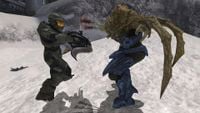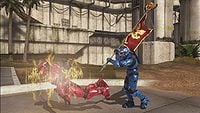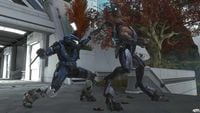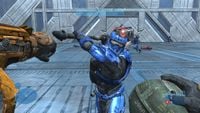Melee
From Halopedia, the Halo wiki
| This article does not have enough inline citations and/or does not adhere to the proper citation format. You can help Halopedia by adding citations. |
Melee is the act of physically attacking an enemy by hitting them with a weapon. In the Halo series, the majority of melee attacks involve using a ranged weapon as a bludgeon, while there are a few weapons that are melee-only. The melee action can be executed by pressing the B button on the default controller layout for the Xbox/Xbox 360 version of Halo: Combat Evolved, Halo 2, Halo 3, and Halo 3: ODST, by pressing the F key on the PC version of Halo: Combat Evolved and Halo 2, or by pressing the RB button on Halo: Reach and Halo: Combat Evolved Anniversary with the default control setting.
Overview
Melee attacks are stealthy and conserve ammunition. The close-range attack causes damage to the target's bones and tissues, allowing an attacker to injure a target without using ammunition. A melee from behind functions by breaking the target's neck or spine, and is sufficient to kill virtually any enemy in the games, regardless of how much shielding or armor they happen to be wearing (with the exception of Hunters and Flood forms). Also, one melee against a sleeping Unggoy, regardless of difficulty or their rank, will kill them instantly.
In Halo: Reach, a new melee feature, called an assassination, is presented. They must hold the melee trigger while being behind the enemy, initially stabbing the opponent from behind to break their opponents' necks.
In Campaign, melees are classified as "silent", thus, without having the need to alert everyone.
Melee attacks are commonly used in multiplayer matches, where only a few blows are needed to kill an opponent; they allow one player to kill another without the sound of gunfire revealing their location or the weapons they are carrying. Melees are more efficient when used from behind.
Occasionally, two players with depleted or near-depleted shields will hit each other at around the same time, resulting in both players dying. While seldom, this can be annoying.
Lunging
<youtube width="200" height="170">YA0HBampRQs</youtube>
When wielding a melee weapon, it is possible to lunge at a distant enemy. If a target is close enough that aiming at them turns an attacker's reticule red, then the attacker can aim at them and press RT. This will cause the attacker to lunge forward before striking.
A lunge delays a melee. If an attacker is wielding the Gravity Hammer, they may find a target and approach them. If the attacker aims away from the target, they can swing the hammer the moment their target gets within the "blast radius", killing the victim almost instantly. If, however, the attacker aims at the target, then the attacker will lunge before striking, even if the target is already within range when RT is pressed. The lunge delays the swing, giving the target more time to react, and creating extra risk for the attacker.
By contrast, lunging is extremely helpful when using the Energy Sword, as it lacks splash damage.
Melee System
Halo 2
Halo 2's melee system was based on three levels of player movement, with a stationary melee doing the least damage, a running melee taking down roughly half of the target's shields, and a jumping melee almost completely removing the target's shields.[citation needed]This does not apply to multiplayer. With the introduction of dual-wielding, a new feature was added: if a player performs a melee attack while dual-wielding, they will drop their left weapon.
In Halo 2, melee attacks had the added benefit of canceling various animations and delays. This trait was shared by various other actions, and was exploited in the form of special button combinations. A common combination is the Double Melee, a rapid repetition of the button sequence B + X.
The range of the melee attack was decreased in Halo 2 from Halo: Combat Evolved, but the distance at which a lunge can be attempted was increased.[citation needed]
Halo 3
In Halo 3, the attack's power increased, such that two blows to a normally-shielded opponent's body were sufficient to kill them. The attack also became more effective against some Campaign enemies, with fewer hits required to kill a Flood Combat Form. A Halo 3 title update balanced melees; if two unshielded players melee each other, both will die, and both will receive a point.
The increased power of Halo 3's melee attack has led to various new tactics and techniques regarding its usage. A common tactic is to charge an opponent using an Assault Rifle; the attacker drains their opponent's shields with the rifle, and then uses a melee to finish them off. Melees are also used in Noob Combos, with a common combo being the usage of a Mauler to drain an opponent's shields, followed by a melee.
A new feature is the ability to perform a normal melee attack while using melee weapons. Such weapons have both an RT attack and a B attack; the former attack is powerful, whereas the latter is faster. The Energy Sword's B attack is a rapid swipe; when pressing B with the Gravity Hammer, a player's character will jab the butt of the hammer forward. It should be noted that this attack causes much less damage than the gravity shockwave, but costs no energy.
Assassinating an opponent in multiplayer earns the player an Assassin Medal, while a normal melee kill yields a Beat Down Medal.
Halo 3: ODST
In Halo 3: ODST, the power of the melee attack has been drastically reduced, because the player characters, ODSTs, are ordinary humans, much weaker than the playable SPARTAN-IIs and Elites from previous titles. Although attacking from the rear is still lethal, it can take several hits from other angles to take down even the lowly Jackal, and trying to take on a Brute in hand-to-hand combat is risky, though 3-4 hits on normal difficulty is still lethal. However, it's still possible to board a tank and destroy it with a few melees, possibly for gameplay reasons, or it may simply have been an oversight on Bungie's part. If you use the Brute Spikers/Brute Shot's "knife" melee however, you would get the same result as a Spartan's melee because of the blades underneath.
Halo: Reach
In Halo: Reach, the melee is weaker then in previous games. Additionally, a new melee feature called "Assassination" is added to the game where players will be pulled into third-person view and watch an animation of their player model executing the enemy, with many of the Assassinations featuring UNSC combat knives (or Sangheili energy daggers if the player is an Elite). The feature is accessible to players by holding down the melee button while behind the enemy. There are more than 40 different animations that change depending on the position, weapon, gametype, and Armor Ability used.[1] Melee attacks are also able to "clang", where if two melee hits connect, instead of both players receiving damage they bounce off of each other instead. This can be used to counter the Energy Sword's "Lunge" attack, which, in previous games, was an instant kill.[2] In addition, if an enemy is in the act of being assassinated my a member of your team, you can in turn steal their kill by quickly killing the individual being assassinated. If you can manage to do so, such an act rewards you with the "Yoink!" medal, and an immediate voice announcing so. It also important to note that when being assassinated an ally can kill the opponent attempting to kill you giving them the medal Showstopper!.
Halo 4
Melee is confirmed to return in Halo 4. Assassinations having originally been introduced within Halo: Reach, are also due to return within Halo 4.[1]
Gallery
A melee performed within Halo 2. It is seen from a first-person perspective.
John-117 melees a Flood combat form; one of the most effective methods of dealing with Flood combat forms in Halo 3's campaign.
A player using the flag to kell another player during a game of Capture the flag.
An Assassination within Halo: Reach.
Melee is the only method of attacking other players in gametypes like Grifball.








